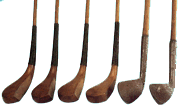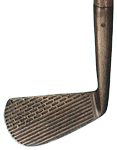
Believe it or not, the very first golf ball was made mostly of goose or chicken feathers. Back in the 1600's, the "feathery cube" consisted of these feathers tightly packed into a cowhide sphere and then wet, which when dried created a nicely hardened ball. Paint was added as a finishing touch, but unfortunately for a handcrafted ball of this type it would sometime cost more then the club used to hit it.

Nearly 200 years later the "feathery cube" was replaced by the Gutta-Percha. Getting its name from the milky juice that is produced from the Gutta tree prominently found in Malaysia, the Gutta-Percha golf ball had a large contribution in the expansion of golf. This hand-crafted ball was much cheaper to produce and could be repaired simply by reheating and shaping the ball. At first the Gutta had a smooth surface, causing them to travel even less then the feathery. Golfers found that after repairing a Gutta ball that had many "nicks" in it, the ball actually worked better. Crafters began making all Gutta's with patterns on them, which led to the development of the next golf ball.

The Bramble succeeded the Gutta, and was designed from some aspect of the Gutta. The textures and patterns that designers had experimented with on the Gutta ball had been very popular. The Bramble took these symmetrical patterns and altered them, making raised spherical bumps all across the surface of the ball. This created the most successful ball the sport of golf had seen yet, and provided concepts useful to the future balls of golf.

The use of a rubber core became the innovator of the golf game. Invented two years before the 20th century, the ball consisted of rubber thread wrapped tightly around the core. Covered by a Balata finish (developed using the Gutta-Percha), the rubber ball used the same symmetrical patterns of raised bumps to cover the entire surface of the ball. Eventually the rubber ball adopted the dimple style for its exterior, which is still scene in all of today's golf balls.

In 1932, the United Stats Golf Association set a standard weight and size for golf balls, following the British whom had set similar standards nearly two years prior. These standards still apply today, and golf balls still contain a solid rubber core (although advances in silicon have been experimented with). However the variety of manufacturers is at an all-time high as these companies aim to help enhance certain aspects of a golfers game just by using their golf ball.
Source: GolfEurope.comSource: TheDesignShop.com

 wearing, players were not required to wear helmets until 1979 when the NHL decided to instate mandatory helmet wearing.
wearing, players were not required to wear helmets until 1979 when the NHL decided to instate mandatory helmet wearing.












